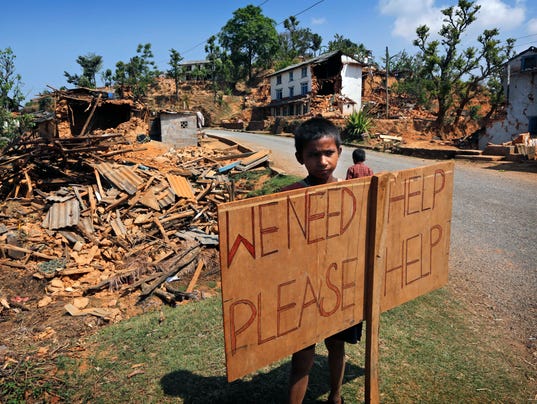Something amazing is happening in the NGO (non-government organizations / charities) sector:
A fundamental rethink of deployment strategies is now under way.
This is really exciting news for everyone, not just those of us that are involved in some way small or large with Disaster Risk Reduction, or DRR for short. After all in today’s world, it is all too easy for any of us to experience a role switch from being a giver of aid to that of being a recipient. You may want to check out my earlier post on Altruism and Resilience and why it pays to be kind.
So, what exactly is taking place and where and when did it all start?
 The devastating Nepal Earthquake seems to have been one of those ‘tipping points’ – although here Malcolm Gladwell’s original concept is blown out of all proportion for there certainly was nothing ‘little’ that made a big difference.
The devastating Nepal Earthquake seems to have been one of those ‘tipping points’ – although here Malcolm Gladwell’s original concept is blown out of all proportion for there certainly was nothing ‘little’ that made a big difference.
Maybe I should borrow the term mother of all wake-up calls instead as a description of how it all started. In any case, what really matters is that things are changing – and, most importantly – for the better.
At first, we received isolated enquiries. More came. Then volunteer groups and now NGOs.
They are requesting custom-made Personal Deployment Kits including Emergency Food to support teams throughout their deployment phase.
Typically teams of between one or two dozen specialists are sent to disaster zones for up to 2 – 3 weeks at which point they are rotated back and replaced if needed. Thus far they brought with them their specialist equipment but relied on local supplies for food and shelter. No longer!
Kits are now being designed by our team so that DRR workers can be fully self-sufficient and avoid placing strain on the local infrastructure. Naturally, kit contents are different depending on the specific situation and organisation so I’m sorry that I can’t give you any teasers nor can I name the involved NGOs thus far.
However, if you are in any way involved as a volunteer or staff in relief or aid work I would encourage you to talk to your organization and get them better prepared with a better integrated and more robust approach.
Things to consider:
– deploying on commercial airlines? Do standard flight safety rules apply on military transports? Items such as matches or flameless-ration heaters (used in food preparation) are restricted for commercial air travel. More info on types of Emergency Survival Food
– how many meals, how many persons? Freeze dried food are lightest and thus easiest to transport and store. They can be reconstituted by adding hot water; see water purification and food preparation
– how much can be stored in a location, how much needs to be carried as for example in a Go-Bag style backpack? Balancing the right contents yet avoiding excess weight is crucial.
Naturally, there is much more to consider but this is a start. Besides, we are always happy to advise so simply give us a call or send us an email.
Have a great week!
Monika
Tweet
thank you for sharing and helping raise awareness for Community Resilience and Preparedness!
For more EVAQ8 blog simply use the right hand navigation. For emergency kits and practical resources use the top navigation. For FREE resources head over to our Preparedness Hub and find out why we use humour. If you like this post, please share it to help raise awareness for Emergency and Disaster Preparedness. Thank you!
Find EVAQ8 on social media, like and follow us!
Rethinking #Resilience: humanitarian Relief Staff capacities in Disaster Zones|https://t.co/bMNUZKf6Ze #charity #NGO pic.twitter.com/PaX9yXGN2T
— EVAQ8 Emergency Kits (@EVAQ8_news) February 12, 2016





Interesting blog. Thanks.
In a disaster, one of many challenges I encountered while being a volunteer was managing the passionate but sometimes inappropriate offers of assistance, and the psychosocial needs of traumatised callers. Call scripts have been developed to support staff and volunteers to manage this but more work is needed in this area.
I work for a humanitarian charity and wish more would be done to build capacities on the ground. Many are only just starting to think that way. I’m glad you’re helping to drive this forward for even better disaster risk reduction.
Love your blog and what you write about around preparedness. Good luck with getting everyone better equipped and informed. You’re doing a superb job.
Interesting find your blog! Off to browse your other posts and main site. Looking great!!
Simply just needed to tell you how glad I am I found your blog and website. Infinitely useful and inspiring. THANK YOU.